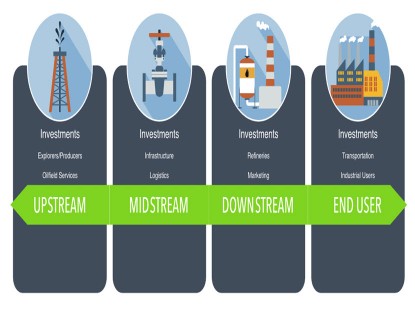The Current Case for Midstream
The Portfolio Managers share their insights on capital expenditure spending, fluctuations of natural gas prices, how Midstream and MLP companies have historically outperformed during periods of high inflation, and the current investment case for midstream companies.
-
 Ben Cook, CFAPortfolio Manager
Ben Cook, CFAPortfolio Manager -
 L. Joshua Wein, CAIAPortfolio Manager
L. Joshua Wein, CAIAPortfolio Manager
Midstream companies significantly outperformed the broader Energy sector in 2023. What are your thoughts on the sector for 2024?
In 2023, the Alerian US Midstream Energy Index rose 19.16% compared to the S&P 500® Energy Index’s one-year return of -1.33%. We are pleased with this performance and believe 2024 will be another positive year for the Midstream sector.
In general, with increased volumes of natural gas and stable-to-rising prices, many companies in the Midstream sector should be able to generate solid results. Even though oil and natural gas prices slightly declined in 2023, there was a significant uptick in U.S. production growth of crude oil, natural gas and liquefied natural gas (LNG). U.S. LNG exports also expanded.
Importantly, Midstream companies generally benefit from their integrated business models. Every touchpoint—gathering, processing, storage, transportation, and exports—provides an opportunity for midstream companies to generate revenue.
As U.S. volumes rise across multiple categories of hydrocarbons, we believe Midstream companies will benefit.
With an opportunity for higher yields across many investment areas, why might investors consider Midstream companies?
We believe Midstream companies offer several attractive attributes, including an attractive yield, favorable distribution growth, and well-funded cash payouts with lower leverage.
With respect to attractive yields, as of 12/31/23, Midstream C-Corps’ current average yield was 6.1%. The average yield of midstream master limited partnerships (MLPs) was 7.5%.1
In addition, distributions represent a meaningful component of total shareholder/unitholder return. Since 2000, the historical midstream sector annual cash payout growth has averaged 5%. During 2024, Wells Fargo Securities Equity Research Analysts have forecasted this trend to continue with cash payout growth projected to rise 5%.
These distributions have been well covered in terms of the amount of cash generated by companies. For example, in 2019, the average distribution coverage in the midstream sector was 1.6x, so every $1 in payout per share/unit was covered by $1.60 distributable cash per share/unit. In 2022, the coverage was 2x, meaning that companies on average covered their distribution by 100%, generating $2 in distributable cash for every $1 paid to investors. Over the next 5 years, the average distribution coverage is forecasted to be 1.8 to 1.9x.1
Finally, Midstream companies have reduced their leverage. Investment grade Midstream sector leverage (debt to EBITDA) was approximately 3.8x at year end 2023, while the 5-year average (2018-2022) has been about 4.2x.1
Following their solid performance in 2023, are Midstream companies attractively valued?
We believe they are. As of the end of 2023, C-Corps traded at 9.1x EBITDA, which is below their 5-year historical average of 10.1x. Midstream MLPs traded at 8.3x EBITDA, slightly lower than their 5-year average of 8.5x as of the same period.1
Combined with a higher-quality balance sheet, consistent distribution growth, and a higher distribution coverage, we believe midstream equities offer attractive valuations.
- In this article:
- Energy
- Midstream Fund
1 - Source: Wells Fargo Equity Research.
You might also like
-
 Investment Idea
Investment IdeaDefining the Energy "Value Chain"
 Ben Cook, CFAPortfolio ManagerRead the Investment Idea
Ben Cook, CFAPortfolio ManagerRead the Investment IdeaEnergy is a large and complex sector. The sector’s broad sub-industries can be divided into a “value chain,” each segment of which has different characteristics and offers different investment opportunities.
-
 Portfolio Perspective
Portfolio Perspective
Energy Transition FundEnergy - Attractively Valued Sector with Higher Free Cash Flow Yields
 L. Joshua Wein, CAIAPortfolio Manager
L. Joshua Wein, CAIAPortfolio Manager Ben Cook, CFAPortfolio ManagerRead the Commentary
Ben Cook, CFAPortfolio ManagerRead the CommentaryIn the following commentary, Portfolio Manager Ben Cook and Josh Wein discuss the Fund’s disciplined process throughout the volatility driven by tariff uncertainty and geopolitical developments.
-
 Portfolio Perspective
Portfolio Perspective
Gas Utility FundNatural Gas: Essential to Reliable Power
 Ryan C. Kelley, CFAChief Investment Officer and Portfolio Manager
Ryan C. Kelley, CFAChief Investment Officer and Portfolio Manager L. Joshua Wein, CAIAPortfolio ManagerRead the Commentary
L. Joshua Wein, CAIAPortfolio ManagerRead the CommentaryUtilities have delivered strong returns in 2025, fueled by demand trends, earnings growth and their defensive nature, positioning natural gas utilities as a compelling opportunity amid market uncertainty.
